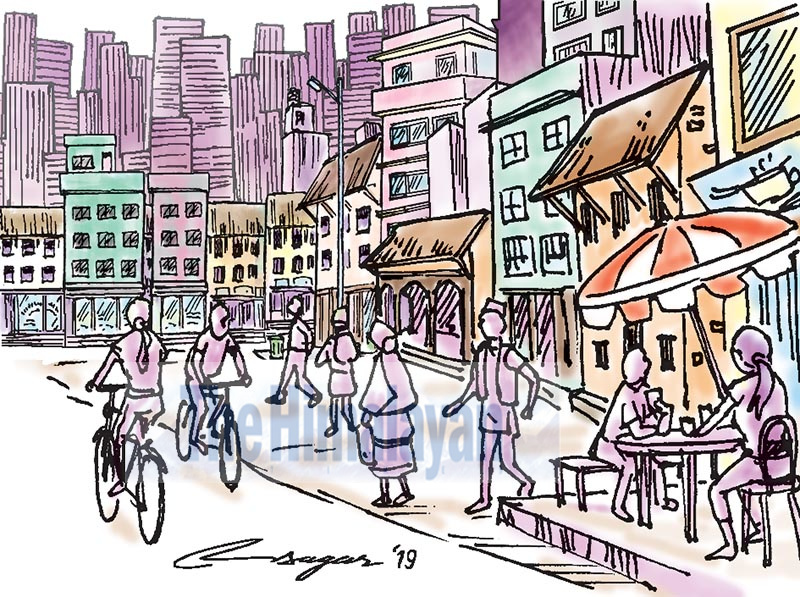Newari architecture: Where are we headed?
The greatest crime an architect of our origin can commit in this century is to see our traditional architecture as only the facade and try to breed it to the functional requirements of a project
Nepal is undoubtedly rich in architecture. Although geographically, culturally and economically influenced by the southern plains and the rugged mountains in the north for more than a thousand years, we can still boast that we have our own unique identity.
All the past rulers, from the early Kirats to the Lichhavis and Mallas, adapted to the indigenous language, culture and traditions of the Kathmandu Valley. Each period made its own distinctive contribution to the valley’s art, culture and architecture. This progressive flow of innovation in architecture brought glory to the city that we can see aplenty today.
Our ancestors lived a life that was self-sustainable, living off the land and building from the land as well, living together around the many bahals and bahils, and sharing knowledge and skills with each other. Looking at our traditional Newari architecture and imagining the life that surrounded it, what we learn is that it manifested out of the sheer necessity of the time it was built in. It was the most contemporary architecture of those times.
The houses lived and breathed along with the inhabitants. The architecture was perfectly proportioned to their needs: 3-3 and a half-storied figure, it basked in the sun in those open courtyards and breathed the air that passed through those narrow alleys. The “sha- jhya” (window) kept an eye on the children playing in those courtyards. When we study the progression of architecture in the valley, we see it constantly innovating and experimenting with different materials and styles.
Although the materials that make up a building are the tangible elements of architecture, we know that architecture is much more than these elements. When we look back and really question the fundamentals of our art and architecture, the real essence of our identity and origin reveals itself. The beauty lies not only in the wood and bricks used, and in their proportion, rather the real beauty lies with the time it was built in for the kind of life it was built for. The intangible aspects of architecture are the shadow created by the existence of a pillar, the front yard and backyard, created by the existence of a building, and a courtyard created by an arrangement of houses.
Even now, nothing beats a well-conserved temple or a house that stood the test of time. When we go inside them, we can even smell the past in the wet mud plastered floor and its smell in the air.
There is no doubt that these buildings need to be conserved so that we can stay rooted in our past and not forget where we came from. But, can we say the same about buildings that are impersonating to be one of them? We can see examples of them all over the valley. The space of a single traditional building gives birth to a number of towering RCC structures, with 8’- 10’ of frontage.
Each sibling varies in height, either because of government regulations or self-guided interests, and tries to outdo the other with traditional elements plastered onto the façade. In some cases, even concrete windows are painted brown.
A naive tourist walks on the streets with a DSLR hung around his neck, oblivious to these happenings, mistakes these buildings for a traditional one instead. Will he judge the palaces and these houses in a single breath?
In a race to identify ourselves with our ancestors, we have been losing the grip on our identity of this time. We see this misrepresentation in many parts of the valley, from
private residential buildings to large government projects.
How did this happen? Where are we right now architecturally? Can a 21st century Nepali architect take a look at the valley right now and be proud of belonging here? When was it the last time that we made a building that we as architects could be proud of? How did the Nepali modern architectural revolution of the 70s and 80s bring us to where we are right now? The spirit of creation in architecture is dying, and we architects need to resurrect it from its grave. Otherwise, misrepresentation is all we will have left to showcase in the near future.
Rather than represent the materials, we have to represent the spirit of our ancestors. Like art, music and any other creative field, architecture must be progressive as well. Of course, when we see a painting that was painted a thousand years ago, we are mesmerised by it. But, if every artist today tries to replicate the same painting, will it still have value?
While living in the present moment, we do not have to hide behind our ancestors and try to sell our designs across. The air we breathe, our existence has value; and the times we live in needs to have its own expression that will live on through the generations. When future generations look back at this time, the buildings need to have the essence of this time as well. They need to know that we did the best we could, and the buildings were built in this time using the techniques and possibilities of this time.
So, the greatest crime an architect of our origin can commit in this century is to see our traditional architecture as only the facade and try to breed it to the functional requirements of a project, like a selectively bred farm animal. By doing that, the spirit of our traditional architecture will only be abused, not appreciated.
Maharjan is an architect






